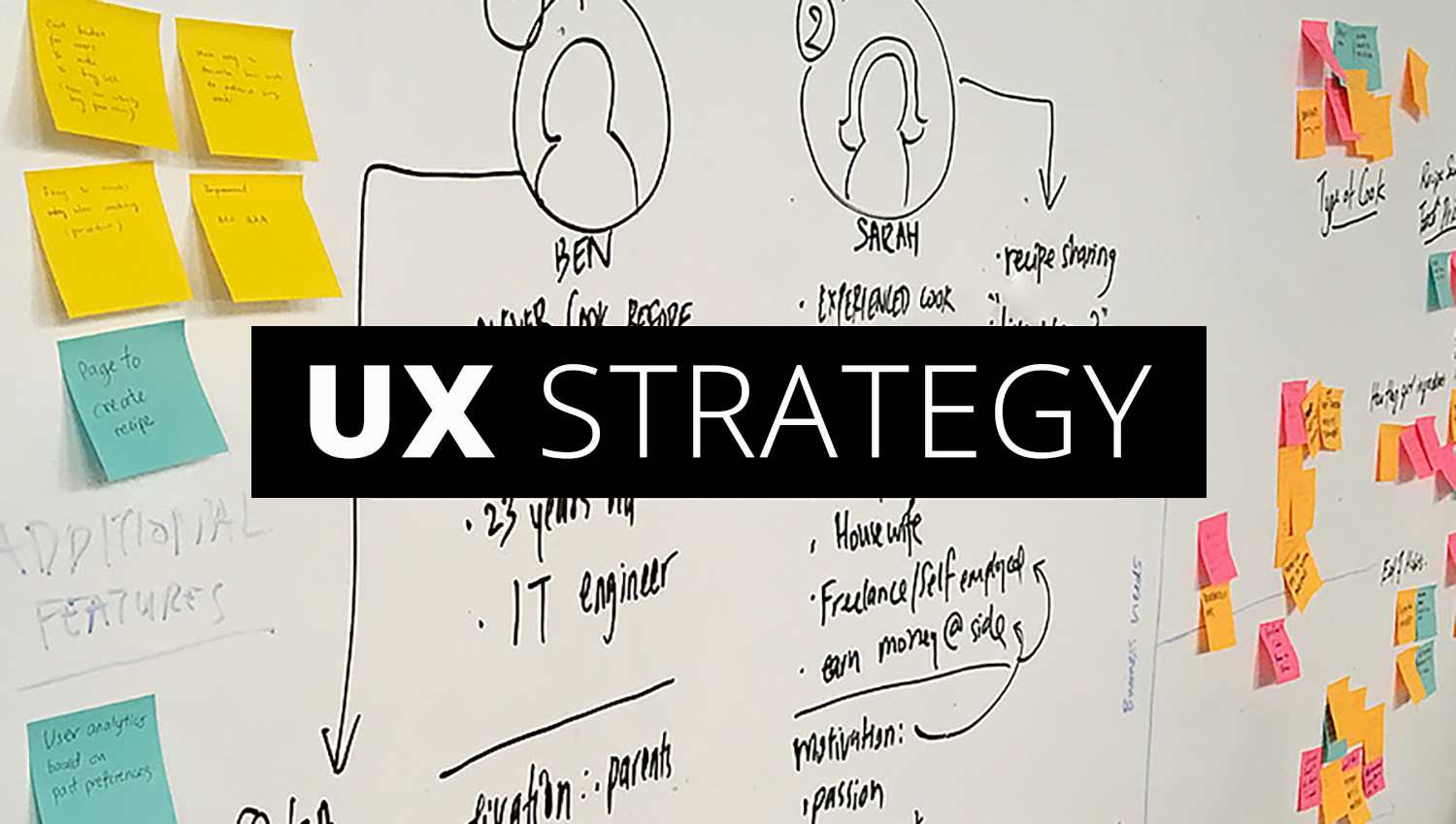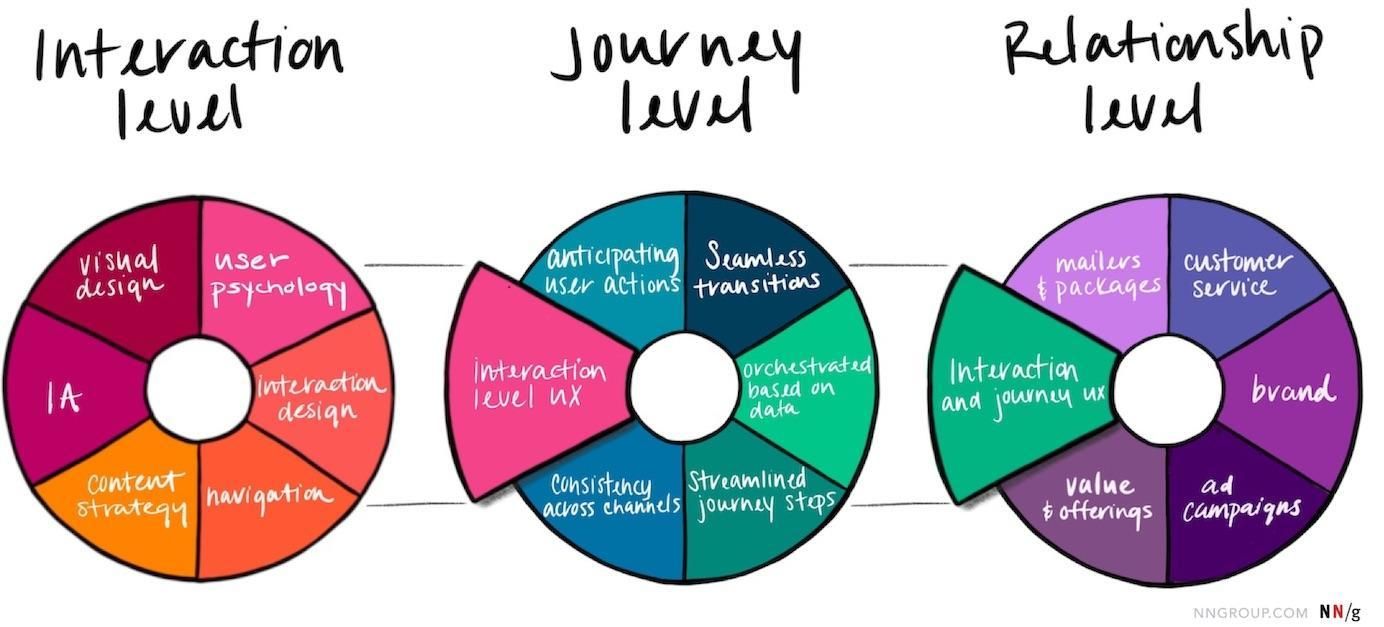Table of contents
1. How UX and design strategies are advancing consumers
2. Phases of strategy creation
3. Techniques for drafting UX strategies
4. Toolbox for UX strategies
5. How it impacts consumers?
6. Final words
1. How UX and design strategies are advancing consumers
UX strategy is focused on how you go about implementing user experience in your software in its pure essence. It is an amalgam of informational elements (existing data, user interviews, feedback, and competitor research), human elements (designers, developers, engineers, SME’s, stakeholders), and desired outcomes (design criteria, features, functionality, and success metrics).
A strong UX strategy incorporates anticipated gains, your team’s workflow, and a vision for improvement. It incubates activity areas and KPIs (Key Performance Indicators) to outline your plan of action.
According to a recent study by Tech Jury, 90% of users stop using an app due to poor performance, while only 1% of users say e-commerce websites meet their expectations every time. Furthermore, 74% of visitors are likely to visit a website back to your website if it offers a good mobile UX. Moreover, the bounce rate increases by 123% if page loading time becomes more than 1 second. Plus, 71% of publishers say that content that looks well-organized on mobile boosts positive user experience feedback.
2. Phases of strategy creation
Now that the tone is set, let’s take a quick look at four prominent phases of UX strategy creation:
2.1 Phase 1: Learning and awareness
While the temptation to simply dive right into things can be intense, but it is better that you take a data-driven approach to learn and research the right approach to a UX strategy. Here it is better to remain specific and define metrics that are measurable such as the need for conversions, increasing user engagement, and quicker task completion.
The main idea is to address the user’s pain point that can result in a success or a failure. It is better to have a roadmap because it can define a path that can lead to your ultimate objective as well as show you where you currently stand.
2.2 Phase 2: Scrutinise the field and draft strategies
The next phase is to identify benchmarks that can help you measure your own performance, and this assessment can include both internal and external environmental elements. A comparative analysis with a rival can be crucial at this point to know your competitor’s main strategy and focus. Secondly, you need to be aware of what consumers in your niche market expect from you and figure out any gaps that have to be filled to meet those expectations.
Hence, you simply cannot focus your entire strategy solely on the aspect of the business but also need to highlight the user, which should right serve as the centre of your UX design philosophy. Here you would also include SMART goals that are specific, measurable, achievable, relevant, and time-restricted along with your KPIs.
2.3 Phase 3: Filter strategies
An unrefined strategy that doesn’t pay attention to detail is a fragile plan at best that can fail at any moment. The reason why planning and research are enlisted in earlier phases is for you to be able to deliver a short, precise, and well-ordered strategy that offers a clear directive for your team.
You should also not undermine the importance of presenting your stakeholders with a real estimation for the ROI (return on investment) from the UX. It is best that you take feedback from them and look into their concerns. Once their qualms are rectified, you can pin up the finalised strategy for everyone else in your team to follow.
2.4 Phase 4: Verify and review
This is the final phase where you execute the strategy, and chances are you might need to tweak your strategy a little to keep up with the current times and stay relevant. You can also consider using prototypes to gratify mission concepts as well as validate them on the go. Validation helps you to identify potential troubles and problematic areas that need your further attention.
Your UX strategy should ideally serve as an intersection between user experience design and the business strategy. On paper, a UX strategy incorporates challenges (business problem), vision (ultimate goal), mission (pathway), activity areas (general practices), and metrics (KPIs and measurements).
3. Techniques for drafting UX strategies

Source: Medium
Similar to software development, you can also utilize techniques to develop US strategies and design to make your process more organized and measurable. Some striking techniques that you can deploy for your UX strategies include:
3.1 Kanban System
Kanban is a lean method that offers a solid conceptual framework while delivering values and principles you need to adhere to and good practices derived from experiences. You can use Kanban to manage and improve all types of projects and work across the human system by balancing the demands with available capacity.
With Kanban, you can also improve handling system-level bottlenecks. Akin to Trello, Kanban utilises a system of boards and cards that make it easy to track different parts of the UX design, and align the workflow of development teams into one place.
3.2 Scrum UX
Scrum is another framework that utilizes practices that involve discovering requirements and developing solutions through a collaborative effort. This involves self-organizing and cross-functional teams along with end-users or customers.
Scrum is typically deployed for delivering and sustaining complex products, and it is perfect for teams that involve ten or fewer members. Goals are used to break down work that has to be completed within time frames known as Sprints that commonly stretch to two weeks but are no longer than one month. Scrum emphasizes an iterative process with incremental progress towards a finished UX design in its most basic form.
3.3 Agile UX
The Agile method is popular, but it is also one of the most common techniques used by developer’s teams. When we talk about Agile UX, it refers to an agile software development principles that are applied and put together with the product with the help of UX specialists.
A UX expert works with an agile team who has the understanding and knows how to evaluate a UX role. This also includes allocating time and budget for the UX’s full design and development process. Lean UX employs an agile process to evaluate and validate notions and ideas, as well as receive swift feedback to enable quick product releases.
4. Toolbox for UX strategies
Without question, when it comes to defining UX strategy, there are several tools that you can effectively use for your UX strategy, such as:
- Competitive analysis tool: When you audit a competitor’s app, product, software or website, it offers you the surety to surpass your rival’s strategy.
- Concept maps: mental models represented through visual maps that the UX team can follow in an enterprise successfully.
- Google’s HEART (Happiness, Engagement, Adoption, Retention, and Task Success) Framework is a splendid tool that helps measure UX performance and improve your product.
- Prototyping tools: refine UX requirements and keep individuals involved that are on board, as well as streamlining the design-test-iterative workflow.
- Sector expert interviews: assist in seeking out ideas and notions from influencers and mine them for further information, especially in an unfamiliar industry.
- Stakeholder reviews: understanding customer/end-user and everyone else’s needs. Kim Goodwin’s iconic checklist for the stakeholder interview can further help the process.
5. How it impacts consumers?

Source: nngroup
I simply cannot stress enough that the UX strategy focuses not only on your business but also on the end-user and their expectations. Here is how UX strategies can impact customers:
5.1 Reduction in risk-taking
Making assumptions can be extremely risky business, which is why your strategy emphasizes validation. An adequate UX strategy can mitigate risk and completely eliminate it by spending a substantial amount of time in research, planning, testing, and corroborating ideas.
By identifying user needs and aligning them with the outset of your project, you can involve aesthetics while still keeping the user at the forefront of the value that you deliver. Since your success depends on how the user determines your product as helpful or not, a well-planned and directed UX strategy would hardly miss out on meeting its targets.
5.2 Prioritisation of features
With the help of a defined UX strategy, you might have difficulty prioritising the problems and pain points you need to tackle with your product. While some may consider the methodology of solving for every use case possible, this rabbit hole is certainly not effective nor the least bit practical. There are always budget and time constraints, and the best way to run around them is to focus on the most important solutions that have to be addressed first.
Especially for MVPs (Minimum Viable Products), it is best that businesses get their product to reach the market, and the best way is to prioritise features that are essential in delivering the best first version. Pupils who opt for dissertation help UK would also consider applications that provide them with the most appropriate and effective features
5.3 Loyalty and satisfaction
It is a fact that customers love well-designed products that are good at offering what they require and also that which they don’t know about but definitely need or want. If your UX strategy can incorporate this ideology, you will certainly end up with customers that are satisfied with your product. This naturally increases your brand loyalty, goodwill, and rapport amongst other audiences in an industry or a market.
Good word of mouth is a powerful marketing channel and can help you gain a tremendous amount of referrals, thus making it simply a priceless asset to have on your side. Young learners who buy research papers online know that loyalty directly corresponds to user satisfaction. Without gratification of user needs, no long-term relationship can be established.
5.4 Return of investment
Everything you do is obviously for the return for which you invested your energies, knowledge, effort, time, and resources. However, it is important that your UX strategy relates to the customer’s experience, as only as you can actually see it affecting ROI positively.
Nowadays, many services providers put the user experience at the center and core of their work processes, such as Airbnb and Google, which boosts conversions. This uplift in profitability nurtures you in the short run and enables the rejuvenation of your resources that you can use to strengthen further your position for the future as well as the long run.
5.5 Enabling Decision-Making
Lastly, a good UX design enables your customers to make decisions. In some manner or way, your UX design should find a mean to be predictive, facilitate automation, and allow users to anticipate results or outcomes. This makes the user become more dependent on your product due to its reliability and offers you a definite edge over the competition.
In some meaning, this can also be tied to the definition of usability of your product. A great UX strategy is able to deliver an end or final product that customers love to use due to its easy and friendly to use design without any shortcomings in its functionality. This makes them fall in love with your products, which is, again, irreplaceable.
6. Final words
Considering UX as something light and not seriously can indefinitely hurt your prospect to make an impact or influence your audience. Not only will you fail to deliver an impression, but in today’s competitive market, it can very well soil your name for good. Agile methodologies have shown how it is far better to start and fix your product later, can then be far less expensive.
A good practice nowadays is to always implement UX early in the product development cycle, as it makes it easier to reach the final product, and it can help pay dividends in other ways too. I hope this post was helpful in offering you some meaningful insights about UX design and development strategies and how they can help the user and potential customers.

